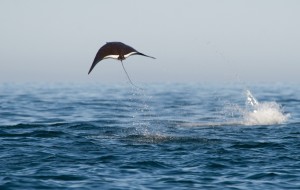Mantas are generally solitary, though may be found in large aggregations in areas where food sources are plentiful, or near to cleaning stations.
Driven by the immense size and power of their wing-like pectoral fins, mantas can reach speeds of up to 15 mph (24 km/hr). At other times, they can hover motionless while being “cleaned” by wrasse and other fish that feed on parasites from the manta’s skin and mouth. Occasionally, several mantas may be observed “queueing up” to wait for their turn at a cleaning station.

Mantas and mobulas occasionally leap from the water
Mantas have been recorded diving to depths greater than 219 m (720 feet). They may also be seen leaping completely out of the water, sometimes performing two or three jumps in succession, and landing with a crashing slap that may be heard for miles around. The purpose of this behaviour is not well understood. It may be playing or social behaviour, related to mating displays or giving birth, or an attempt to get rid of parasites such as remoras.
When threatened, mantas will curl one pectoral fin toward the back and the other toward the belly, forming an s-shape while exposing their dorsal surface towards the threat.
